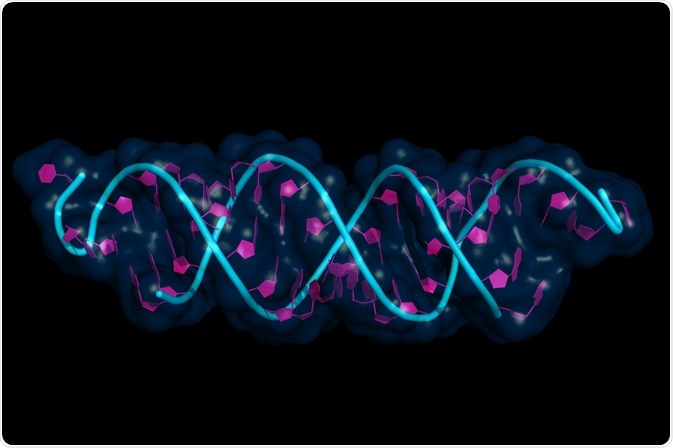The collection of RNA molecules in a cell, known as the transcriptome, holds the key to a wealth of useful information. It can tell us where genes are turned on and off, as well as uncovering to what extent the gene is active.
RNA sequencing is a method that allows scientists to look into the transcriptome of a cell and acquire this information.
Assays that carry out RNA sequencing have advantages over previous methods of investigating gene expression such as Sanger sequencing and microarray-based methods because they provide a higher resolution and greater coverage of the transcriptome.
In addition to gaining insight into the gene expression within cells of tissues and organs, these assays can identify novel transcripts and find alternatively spliced genes, as well as uncovering allele-specific expression.

Image Credit: Petarg/Shutterstock.com
RNA assays have benefited from recent advancements in their processes, making them capable of determining the functional complexity of transcription. Modern assays can be used to explore total RNA, and the different subtypes of RNA such as pre-mRNA, microRNA, small interfering RNA, and long ncRNA.
The significance of RNA assays is that they provide a global transcript profiling tool that is likely to be essential for developing our understanding of how genes influence illness and more, as well as to develop new diagnostic tools and even treatments.
Types of RNA assay
The main classifications of RNA assay are library preparation, small RNA/non-coding RNA sequencing, direct RNA sequencing, and cDNA synthesis. While these aren’t the only methods, they are those that are well-established and have already proven themselves useful within numerous biological disciplines.
The library technique encompasses three general steps: RNA isolation, RNA selection/depletion, and cDNA synthesis. RNA isolation involves separating RNA from the tissue and mixing it with deoxyribonuclease.
A gel is then used to measure RNA degradation, and capillary electrophoresis calculates an RNA integrity number to the sample. During RNA selection/depletion the isolated RNA can be filtered to select that which binds to specific sequences. Finally, RNA is reverse transcribed into cDNA to enable amplification. This stage allows the sequence to be analyzed.
The technique known as small RNA/non-coding RNA sequencing is a modification of the library method. It involves RNA being selected based on a targeted size range. A size-exclusion gel, magnetic beads or a commercially developed kit is used to isolate the desired size of RNA. This isolated DNA is then purified, and reverse transcribed into cDNA.
Direct RNA sequencing was established to overcome the flaws of the previous methods that rely on converting RNA into cDNA, amplification, ligation and other manipulations that introduce error. Single-molecule direct RNA sequencing uses a massively parallel manner to sequence RNA molecules directly, and remove this risk of introducing biases.
Finally, the methods of single-cell RNA sequencing (scRNA-Seq) have been developed to analyze the expression of RNAs from large populations of cells. Methods like microarrays and standard bulk RNA-Seq are assays encompassed in this classification. They can be used to generate expression profiles of individual cells, although they do not provide a comprehensive look into every single RNA expressed within a sample cell. Rather, patterns of gene expression are determined by gene clustering analysis, which has proven to be crucial in identifying rare cell types.
Newer methods include quantitative reverse transcriptase-PCR (qRT-PCR), a method that again relies on the transcription of RNA to cDNA, which is then used as a template for the qPCR reaction. This method has already been used in several applications such as RNAi validation, gene expression analysis, microarray validation, genetic testing, pathogen detection, and disease research.
Other newly evolving methods include next-generation RNA sequencing, and multiplex digital color-coded barcode technology, which has been used recently in studies of those with non-small cell lung cancer.
Clinical use of RNA assays
RNA assays have become well established in various clinical applications. They have proven their use in developing our knowledge of, and assisting in the diagnosis, prognosis, and assessment of therapeutic suitability in several diseases, such as different types of cancer, a variety of infectious diseases, and infections such as HPV.
The techniques have also driven considerable insight into the development of embryos and organisms.
Possibly the most valuable function of RNA assays is in identifying gene fusions and differential expression of transcripts that are already recognized as being fundamental in the initiation of disease. There is a great opportunity to use RNA assays in this field.
Also, RNA assays are being used in research that will eventually impact the clinical landscape. For example, extracellular RNAs are being explored as potential non-invasive diagnostic indicators of disease. As research continues we may see the development of benchmark standards and assay optimization in this area, opening it up to clinical use for this purpose.
The future could see these assays helping to develop RNA molecules as therapeutic agents. Future developments are also likely to see the improvement of RNA assays, opening them up to use in more applications, primarily in the fields of autoimmune disease, development, infectious disease, oncology, and neurology.
Sources:
- Cattani, P., Siddu, A., D'Onghia, S., Marchetti, S., Santangelo, R., Vellone, V., Zannoni, G. and Fadda, G. (2009). RNA (E6 and E7) Assays versus DNA (E6 and E7) Assays for Risk Evaluation for Women Infected with Human Papillomavirus. Journal of Clinical Microbiology, 47(7), pp.2136-2141. https://www.ncbi.nlm.nih.gov/pmc/articles/PMC2708475/
- Kukurba, K. and Montgomery, S. (2015). RNA Sequencing and Analysis. Cold Spring Harbor Protocols, 2015(11), p.pdb.top084970. https://www.ncbi.nlm.nih.gov/pmc/articles/PMC4863231/
- Malapelle, U., Pisapia, P., Cieri, M., Pepe, F. and Troncone, G. (2018). RNA-Based Assays. Molecular Diagnostics in Cytopathology, pp.99-119. https://link.springer.com/chapter/10.1007/978-3-319-97397-5_6#citeas
- Sullenger, B. and Gilboa, E. (2002). Emerging clinical applications of RNA. Nature, 418(6894), pp.252-258. https://www.ncbi.nlm.nih.gov/pubmed/12110902
Further Reading